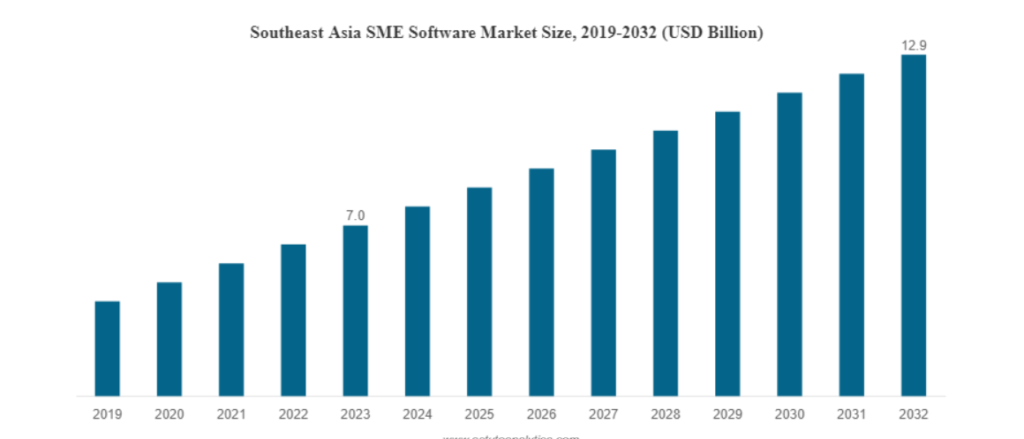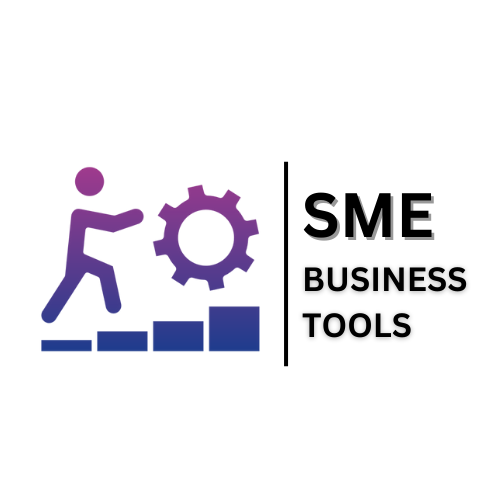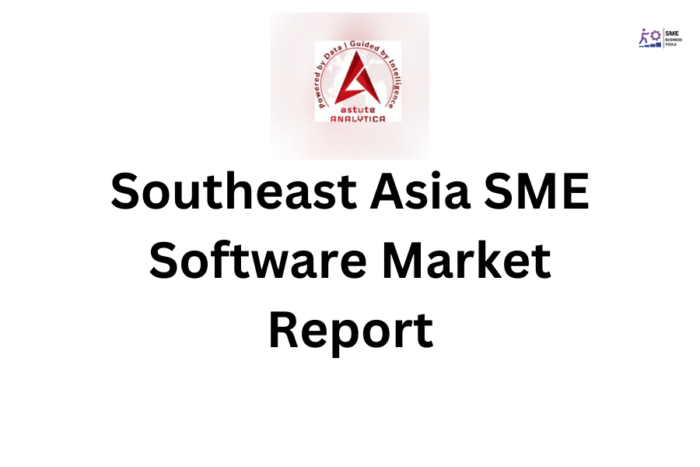Table of Contents
The Southeast Asia SME software market is experiencing significant growth, driven by rapid digital transformation and increased technology adoption among small and medium enterprises (SMEs). In 2023, the market was valued at approximately USD 7.0 billion and is projected to reach USD 12.9 billion by 2032, growing at a compound annual growth rate (CAGR) of 7.1% during the forecast period from 2024 to 2032. This expansion underscores the crucial role of over 70 million SMEs in the region, contributing significantly to employment and GDP.

Key Players in the Southeast Asia SME Software Market
Several major companies dominate the SME software market in Southeast Asia, offering a range of solutions tailored to the needs of small and medium enterprises. These top players include:
- Oracle Corporation
- Microsoft Corporation
- SAP SE
- Intuit Inc.
- Sage Group PLC
- Zoho Corporation
- Freshworks Inc.
- Salesforce.com, Inc.
- HubSpot, Inc.
- Xero Limited
These companies lead the market in providing cloud-based solutions, customer relationship management (CRM) software, accounting tools, and more, all designed to enhance SME operations and competitiveness.
Market Segmentation Overview
The SME software market in Southeast Asia can be segmented into various categories based on services, deployment type, industry, and country. Each segment plays a vital role in shaping the market dynamics.
By Offering
The market is segmented into several service categories, with key areas including:
Infrastructure as a Service (IaaS)
Dominates the market with over 44.8% market share. IaaS provides virtualized computing resources over the internet, allowing SMEs to scale their infrastructure as needed without the expense of physical hardware.
Platform as a Service (PaaS)
This service is growing in popularity, especially among SMEs looking to develop, run, and manage applications without the complexity of building and maintaining the infrastructure themselves.
Software as a Service (SaaS)
Widely adopted across the region, SaaS offers a subscription-based model for accessing software applications online, such as CRM, ERP, and HR management tools.
By Deployment Type
Deployment types are categorized into:
Cloud-Based Solutions (SaaS)
Cloud-based deployments are preferred by SMEs for their cost-effectiveness, flexibility, and scalability. These solutions enable businesses to access software and data remotely, fostering collaboration and reducing the need for on-premises infrastructure.
On-Premises Solutions
While cloud solutions dominate, some SMEs, particularly larger ones or those with specific security needs, continue to rely on on-premises software that is installed and runs on the company’s own servers.
By Industry
- BFSI
- Education
- Consumer Goods
- Retail
- Product tracking
- Real-time data and analytics
- Automate processes
- Inbound and outbound reads
- Others
- Public sector
- Manufacturing
- Healthcare & Life science
- Telecommunication
- Media & Entertainment
- E-Commerce Marketplaces
- Others
By Country
The market dynamics vary significantly across different countries in Southeast Asia:
Singapore
Singapore leads the region in technology adoption, with widespread use of artificial intelligence (AI) and cloud-based solutions across various industries. The country’s robust digital infrastructure and supportive government policies have made it a hub for innovation.
Indonesia
Indonesia is experiencing rapid growth in e-commerce and digital payments, driving the demand for SME software, particularly in the retail and financial services sectors.
Vietnam
Vietnam has seen significant investments in retail and manufacturing software, reflecting the country’s growing industrial base and increasing focus on efficiency and productivity.
Thailand
In Thailand, the manufacturing sector is a major adopter of ERP systems, which are used to streamline operations and enhance competitiveness in the global market.
Malaysia
Malaysia is witnessing increasing use of financial management, CRM, and HR software, particularly among SMEs looking to improve their operational efficiency and customer engagement.
Market Growth Drivers
Several factors are driving the growth of the SME software market in Southeast Asia:
Digital Transformation
The ongoing digital transformation across Southeast Asia is pushing SMEs to adopt new technologies to stay competitive. This transformation is particularly evident in sectors such as retail, finance, and manufacturing, where software solutions are becoming integral to daily operations.
Cloud Computing
The widespread adoption of cloud computing is another major growth driver. Cloud-based solutions offer flexibility, scalability, and cost savings, making them particularly attractive to SMEs with limited IT resources.
Government Initiatives
Governments across Southeast Asia are actively supporting the digitalization of SMEs. Initiatives such as grants, subsidies, and training programs are helping SMEs adopt new technologies and improve their business processes.
Fintech Solutions
The rise of fintech solutions is also contributing to market growth. SMEs in Southeast Asia are increasingly using fintech platforms for payments, lending, and financial management, driving demand for related software.
Challenges and Opportunities
While the Southeast Asia SME software market is poised for growth, it also faces several challenges:
Financial Constraints
Despite the benefits of digitalization, many SMEs in the region still face financial constraints that limit their ability to invest in new software solutions. This challenge is particularly acute for micro and small enterprises with limited budgets.
Cybersecurity Concerns
As SMEs adopt more digital tools, they become more vulnerable to cyber threats. Ensuring robust cybersecurity measures is crucial for protecting sensitive data and maintaining trust among customers and partners.
Skills Gap
The lack of digital skills among SME employees can hinder the effective implementation and use of new software solutions. Training and upskilling programs are essential to bridge this gap.
However, these challenges also present opportunities for growth:
Affordable Solutions
The development of affordable, scalable software solutions tailored to the needs of SMEs can help overcome financial constraints and drive adoption across the region.
Fintech Integration
The integration of fintech solutions with SME software presents a significant growth opportunity. By offering seamless, integrated platforms, software providers can meet the evolving needs of SMEs in the region.
Government Support
Continued government support, in the form of incentives and training programs, can help SMEs overcome challenges and fully embrace digital transformation.
Conclusion: A Promising Future for SME Software in Southeast Asia
The Southeast Asia SME software market is poised for substantial growth, driven by rapid digitalization, technological advancements, and the increasing adoption of cloud-based solutions. Despite financial constraints, fintech solutions and government support offer promising avenues to overcome barriers. As SMEs continue to play a crucial role in the region’s economy, their adoption of digital tools and software solutions will be key to driving innovation, enhancing competitiveness, and ensuring sustainable growth in the years to come.
Report from Astute Analytica.





 Business Support Programme for Warwickshire Manufacturing SMEs
Business Support Programme for Warwickshire Manufacturing SMEs